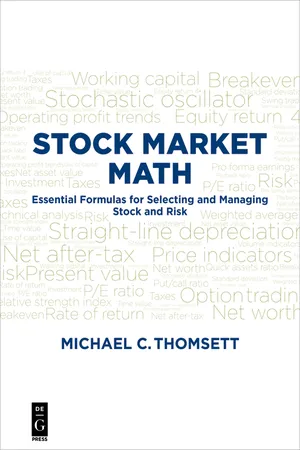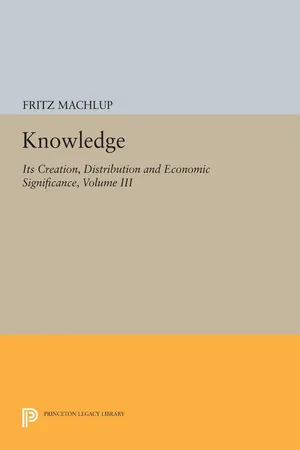Business
Rate of Return
Rate of return is a measure used to evaluate the efficiency of an investment. It calculates the gain or loss on an investment relative to the initial amount invested. It is expressed as a percentage and is a key metric for assessing the profitability of an investment.
Written by Perlego with AI-assistance
Related key terms
1 of 5
4 Key excerpts on "Rate of Return"
- eBook - ePub
Stock Market Math
Essential formulas for selecting and managing stock and risk
- Michael C. Thomsett(Author)
- 2017(Publication Date)
- De Gruyter(Publisher)
Chapter 1 Rates of Return on Investment: What Goes In, What Comes Out Even the most seemingly easy calculation can become quite involved.For example, what is your “return?” If you invest money in a stock or mutual fund, you need to be able to figure out and compare the outcome; but as the following explanation demonstrates, there are many different versions of “return” and you need to be sure that when comparing two different outcomes, you are making a like-kind study. Otherwise, you can be deceived into drawing an inaccurate conclusion. And accuracy is one of your goals in going to the trouble of drawing conclusions in the first place.The “return” you earn on your investments can be calculated and expressed in many different ways. This is why comparisons are difficult. If you read the promotional literature from mutual funds and other investments, the return provided in the brochure could be one of many different results.This is why you need to be able to make distinctions between return on investment and return on capital . Your investment return is supposed to be calculated based on the amount of cash you put into a program, fund or stock. Most investors use “return on investment” in some form to calculate and compare. The return on capital is usually different and is used by corporations to judge operations. To further complicate matters, “capital” is not the same as “capitalization” so corporate return calculations can be difficult to compare. Return on capital normally means capital stock. Capitalization is the total funding of an organization, including stock and long-term debt.A business model of return on capital may present problems, however. Accuracy is in question when the calculation is based on a fixed value, such as capital, versus current value of the same investment: - eBook - PDF
Knowledge: Its Creation, Distribution and Economic Significance, Volume III
The Economics of Information and Human Capital
- Fritz Machlup(Author)
- 2014(Publication Date)
- Princeton University Press(Publisher)
Times may change, interest rates may come down, and additional schooling may eventually fetch higher returns than it seems to do at the moment. Hence, options are acquired. CHAPTER 21 RATES OF RETURN TO INVESTMENT IN EDUCATION THIS CHAPTER is to serve a variety of purposes. I intend it to make a more explicit and didactic statement about the size of returns to capital and the Rate of Return; to report on findings from empirical research on rates of return to investment in learning; to question some of the theoretical and statistical premises of this kind of re- search, perhaps even to cast doubt regarding its basic presupposi- tions; and to provide a summary of several issues treated in the preceding chapters. The Size and the Rate In simplest terms, the size of returns means dollars and the rate means per cent. If the returns come in as a series of receipts, a flow over time—perhaps over a lifetime—they can be expressed in a single magnitude as a present (capitalized) value, where each future receipt is discounted at a given rate. If the returns are to be compared with a given stock of capital (or with a given flow of investments), and the quantitative relation between returns and capital (investment outlays) is to be shown, one does not use a given rate of discount, or rate of capitalization, but, instead, calculates the internal Rate of Return. This is the rate that reduces the expected future returns to a present value equal to the given accumulated stock of capital (the sum of investment outlays plus interest up to the present). 1 Several implications of these statements are obvious, but others may be quite difficult to handle. It is easy to see that future outlays and receipts may have rather low present values because of the dis- counting. - eBook - ePub
- Robert Irons(Author)
- 2019(Publication Date)
- Routledge(Publisher)
FP2 states that there is a direct (or positive) relationship between perceived risk and required return. This principle is clearly seen when calculating expected returns using the Security Market Line. PR3 examines the inverse relationship between value and the risk, while PR1 describes the inverse relationship between value and the discount rate. These two precepts are linked by the direct relationship between risk and return, since the return to shareholders is used as the discount rate for valuing the firm’s common shares.Measuring Return
The percentage return (or yield) on an investment is measured as the change in the value of the investment over the time period in question, plus any cash flows from the investment, divided by the value of the investment at the beginning of the time period. The numerator of this fraction is the dollar return on the investment, and dividing the dollar return by the beginning price makes it a percentage return (a percentage of the price). Stocks and bonds both have cash flows that occur during the year: dividends for stocks and interest payments for bonds.Typically, when people in finance refer to returns, they are referring to percentage returns, not dollar returns. Percentage returns indicate the size of the return relative to size of the investment, and therefore can be used to compare returns for different investments, regardless of the amount invested. For example, suppose you and your best friend both invested for one year, each in a different stock. At the end of the year, you had earned $1,000 on your investment, while your friend had earned $500 on hers. Which of you did better? The correct answer is it depends on how much each of you invested. If you invested $5,000, while your friend invested $1,000, then she earned a 50% return while you only earned a 20% return. When we refer to returns in this textbook, we will usually be referring to percentage returns. - eBook - PDF
Real Estate Appraisal
From Value to Worth
- Sarah Sayce, Judy Smith, Richard Cooper, Piers Venmore-Rowland(Authors)
- 2009(Publication Date)
- Wiley-Blackwell(Publisher)
Measuring return 11 11.1 Introduction Performance measurement has become increasingly important in the property market as investors have become more sophisticated and demanding. Fund managers are expected to meet or exceed a specified benchmark on a regular basis. In order to facilitate calculations and comparisons of individual property and portfolio performance, common standards have evolved. This chapter examines a number of methods used to calculate returns grouped under two main methodologies: money-weighted returns and time-weighted returns. Returns can be defined simply as the income and capital appreciation from an investment, expressed as a percentage of capital invested. Accordingly, total returns can be segmented into income returns and capital growth. Returns provide a consistent measure to assess the investment performance across the assets of an investor. A distinction should be made between yields and returns. Generally yields are a ratio of current annual income from an investment expressed as a percentage of current value. Yields tend to be a ‘snapshot’ at a given moment in time. For instance, an initial yield on a property investment is the ratio of net annual income to gross capital value. Returns relate to income and capital gains over a specific period, such as a month or year. However, the distinction is blurred by yields such as redemption yields on bonds, which are the internal Rate of Return on a bond held to redemption at the current price. 11.2 Simple return Simple return is a straightforward method used to calculate a return over a period. The formula below includes start and end period and market values plus cash flow over the period. TR = EMV − BMV − CE + NI BMV Aims of the chapter • To explain the requirement to measure investment performance. • To introduce the concept of perform-ance measurement. • To discuss the nature and construc-tion of property indices.
Index pages curate the most relevant extracts from our library of academic textbooks. They’ve been created using an in-house natural language model (NLM), each adding context and meaning to key research topics.



